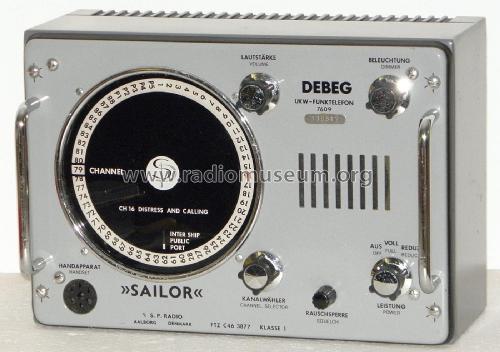VHF Radiotelephone UKW-Funktelefon Sailor RT144 DEBEG 7609
SP Radio (S.P.), Sailor Marineradio; Aalborg
- Paese
- Danimarca
- Produttore / Marca
- SP Radio (S.P.), Sailor Marineradio; Aalborg
- Anno
- 1974
- Categoria
- Ricetrasmettitore commerciale (TRX non amatoriale)
- Radiomuseum.org ID
- 284364
-
- Brand: Sailor
- Numero di transistor
- A semiconduttori.
- Semiconduttori
- Principio generale
- Ricetrasmettitore; ZF/IF 10700/400 kHz
- Gamme d'onda
- Gamme d'onda nelle note.
- Tensioni di funzionamento
- Batteria di accumulatori, per tutto (es. autoradio, radio amatoriali) / 12/24 Volt
- Altoparlante
- AP magnetodinamico (magnete permanente e bobina mobile) / Ø 8 cm = 3.1 inch
- Potenza d'uscita
- 2.5 W (indistorta)
- Materiali
- Mobile di metallo
- Radiomuseum.org
- Modello: VHF Radiotelephone UKW-Funktelefon Sailor RT144 DEBEG 7609 - SP Radio S.P., Sailor
- Forma
- Soprammobile basso, con andamento orizzontale (grosse dimensioni).
- Dimensioni (LxAxP)
- 320 x 220 x 165 mm / 12.6 x 8.7 x 6.5 inch
- Annotazioni
-
Sprechfunkgerät für Schiffe, Frequenzbereich 156,0 - 168,2 MHz, 88 internationale Seefunkkanäle und 5 Privatkanäle.
Sendeleistung umschaltbar 25 W/1 W, Phasenmodulation. NF-Ausgangsleistung 2,5 W.Als DEBEG-Gerät Zulassung FTZ C46 3877.
- Peso netto
- 9 kg / 19 lb 13.2 oz (19.824 lb)
- Bibliografia
- -- Original-techn. papers. (Instruction Book for Sailor RT144)
- Autore
- Modello inviato da Siegfried Droese. Utilizzare "Proponi modifica" per inviare ulteriori dati.
- Altri modelli
-
In questo link sono elencati 52 modelli, di cui 46 con immagini e 22 con schemi.
Elenco delle radio e altri apparecchi della SP Radio (S.P.), Sailor Marineradio; Aalborg
Collezioni
Il modello VHF Radiotelephone UKW-Funktelefon fa parte delle collezioni dei seguenti membri.
Discussioni nel forum su questo modello: SP Radio S.P.,: VHF Radiotelephone UKW-Funktelefon Sailor RT144 DEBEG 7609
Argomenti: 1 | Articoli: 1
This radio has a couple of features that make is pretty unique.
Firstly, it derives all its synthesized frequencies from a single crystal oscillator. Even the local oscillator that is used to get from the first receiver IF to the second (400kHz) is done with this crystal source. So if you calibrate the master oscillator, everything is dead on frequency. Such an approach was very novel in 1976, the year this radio first entered the market.
The second thing to mention is the synthesizer. This is completely done in discrete TTL chips, no custom chips or CPU/firmware was used. The advantage of this is that potentially needed spare parts are easy to find, even in 2024, and you won't have to deal with "bit rot" due to EPROMS losing their data after almost 50 years. TTL chis can still be purchased today in abundance, or buy the level compatible HCT chips (which is actually fast, low-power CMOS but drop-in compatible with TTL) .
The synthesizer programming does not use EPROMS but is programmed by screws and bumps on a large brass disk, like a vintage music box. This allows you to program the radio on frequencies outside the VHF marine band. As an example, I programmed mine with one of the license-free MURS channels here in the US (154.600 MHz). The radio's dial offers six user-programmable slots for this.
As a third, the radio is very sensitive, still on par with the best VHF radios you can buy today.
Last but not least, the radio is of modular construction and easy to repair, everything can be reached with ease. The manuals are well written and clear, which also helps in case you need to do repairs.
In short: a great collector's item!
Loek d'Hont, 01.Jan.24
